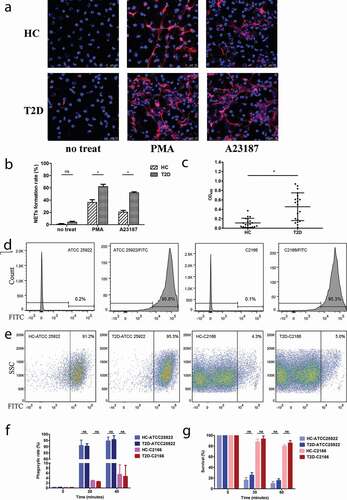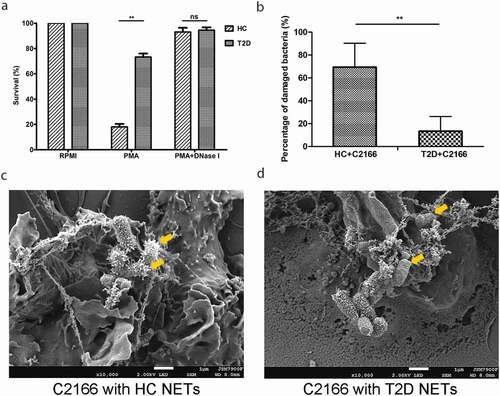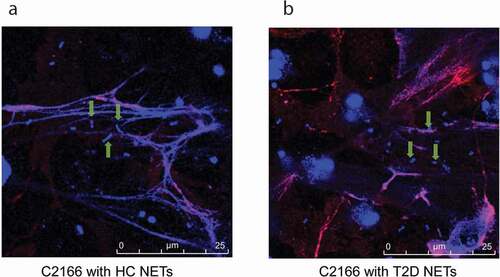Figures & data
Figure 1. Representative immunofluorescence images (a) and quantification of the percentages of neutrophils undergoing NETosis (b) in the presence of PMA (20 nM) and A23187 (1 μM). Type 2 diabetes mellitus patients (T2D) neutrophil form more extracellular traps than healthy controls (HC) with the same stimulation. For the NETs induction, samples from five diabetics and five healthy volunteers were included. Neutrophils from each sample were induced by PMA or A23187 on three separate coverslips and six random fields were acquired per coverslip. On average, each field approximately contains 81 cells and each sample can count about 1400 cells. (c) Quantification of MPO-DNA complexes in serum samples of HC and T2D patients. (d-g) CR-hvKP C2166 showed highly resistant to neutrophilic phagocytosis using different assay methods. (d) E. coli ATCC 25922 and K. pneumoniae C2166 have a comparable efficiency of FITC labeling and more than 95% of the population can be stained effectively. (e) CR-hvKp C2166 displayed similar levels of resistance to phagocytosis by healthy and diabetic neutrophils after 40-min incubation. E. coli strain ATCC 25922 is susceptible to neutrophil phagocytosis and used as neutrophil phagocytosis function control in this study. (f) FITC-labeled bacteria detection based on flow cytometry; (g) CFUs recovery percentage based on DNase I treated neutrophil killing assays. ns, no significance; *p < 0.05: SSC, side scatter.

Table 1. Major virulence and antimicrobial resistance mechanisms were detected in carbapenem-resistant hypervirulent K. pneumoniae C2166 and counterpart reference strains using whole genome sequencing data.
Figure 2. (a) Healthy controls (HC) and type 2 diabetes mellitus (T2D) patients NETs in vitro killing of CR-hvKP C2166. NETs were induced by 100 nM PMA for 3 h, then C2166 (1 × 106 CFUs) were added and co-incubated for another hour. After cells lysing, C2166 were plated on LB agar and enumerated the next day. HC and T2D patients NETs were combined with C2166 and bacterial surface were analyzed under scanning electron microscope. The mean percentage of surface-damaged bacteria by HC and T2D NETs was compared and shown in (b). Representative images were presented in (c) and (d). **p < 0.01, ns: no significance.


